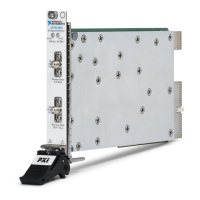NI PXI-5650/5651/5652 Calibration Procedure | © National Instruments | 11
5. Repeat steps 3 through 4 for every power level down to -38 dBm, using a step size of 2 dB
on the even values (5, 4, 2, 0, ..., -38).
6. Repeat step 5 for the remaining frequencies using the corresponding Start Power listed in
Table 4.
Verifying Low Power Level Accuracy
Note Prior to starting this procedure, characterize the spectrum analyzer according
to the Characterizing the Spectrum Analyzer section of this document.
Complete the following steps to verify the low power level accuracy (≤-40 dBm) of the
PXI-5650/5651/5652 module using a spectrum analyzer:
1. Connect the PXI-5650/5651/5652 REF IN/OUT front panel connector to the rubidium
10 MHz frequency reference signal.
2. Connect the 6 dB precision attenuator to the PXI-5650/5651/5652 RF OUT front panel
connector.
Note You must use the same attenuator you used in the Characterizing the
Spectrum Analyzer procedure.
3. Connect the spectrum analyzer RF INPUT connector to the 6 dB precision attenuator.
4. Connect the rubidium 10 MHz frequency reference signal to the spectrum analyzer
10 MHz REF IN rear panel connector.
5. Generate a single-tone signal after setting the following NI-RFSG property settings:
• Frequency (Hz): 500 kHz
• Power Level (dBm): -40 dBm
• Generation Mode: CW
• Reference Clock source: RefIn
6. Use the NI-RFSG Property Node to read the actual frequency of the generated signal. The
actual frequency varies slightly from the configured frequency.
7. Configure the spectrum analyzer with the following settings:
• Frequency: NI-RFSG frequency (Hz) value obtained in step 6
• Reference level: -44 dBm
• Resolution bandwidth: 30 Hz
• Frequency span: 0 Hz
• Reference Clock source: External
• Trace averaging: 20 traces

